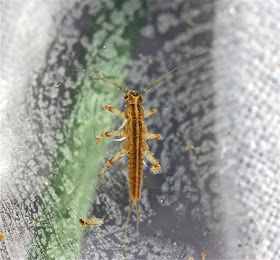Saturday, November 26, 2011
Clioperla clio: And They're Already Big!
One of the earliest Perlodid stoneflies we find in our streams -- and one of the first to mature in the new year -- is the one in the photo above: Clioperla clio (there is only one species of Clioperla). Last winter, I found a lot of them in Buck Mt. Creek. So I went there this morning hoping to start seeing some young ones. I did, but I also found three, like the one in the picture above, that were already fairly mature. I was amazed.
But according to Stewart and Stark (Nymphs of North American Stonefly Genera, p.381), this is a nymph that exhibits "fast-seasonal growth." From the growth of the nymphs that I saw last year, I'd say that this is a species that hatches mainly in March and April. I also discovered last year that Clioperla clio is an "aggressive" predator! I lost more than one small minnow mayfly to hungry Clioperlas. This is confirmed by Stewart and Stark (p. 381): "Feminella & Stewart (1986) found C. clio nymphs consistently among leaf litter throughout the year, and mature nymphs were found to be major predators of leaf pack-dwelling invertebrates." When you have some of these nymphs in your tray be careful about putting other nymphs with them.
C. clio nymphs are easy to spot because of their heads: a large area of yellow, encircled by a band of black or brown. Let me quote again from Stewart and Stark (p. 381): "Head mostly yellow with dark bands extending through or behind lateral ocelli to compound eyes and across anterior margin of frons, enclosing large yellow quadrangular area."
Anatomically, Clioperlas are put together a lot like Isoperlas. They have a very clear "Y" ridge (mesosternal), and the lacinia has two teeth at the end, followed by a series of smaller teeth or setae.
Pictures.
And the lacinia
From these features, Peckarsky (Freshwater Macroinvertebrates, p. 73) takes us to the following couplet:
45a. Dorsal abdominal segments with alternating transverse or longitudinal light and dark stripes or bands .... Isoperla
45b. Dorsal abdominal segments uniform, brownish except for a few small light spots (which may be in longitudinal rows).... Clioperla
No doubt about the color of those abdominal segments, and, the "light spots" are visible as well. Clioperla clio. Some more photos or this beautiful nymph.
___________
I was also hoping to see maturing large and small winter stoneflies today. The small winters are clearly starting to color up with darker wing pads; the sole large winter stonefly I found was not much bigger than those I found here last week.
small winter (Capniidae, genus Allocapnia)
large winter (Taeniopterygidae, genus Taeniopteryx)
Oh. And I mentioned last week that Allocapnia small winter stoneflies have "truncated" rear wing pads that are often "notched". These clearly were.
One more look at the "catch of the day."











replica bags by joy recommended you read j1a60m0m10 replica bags wholesale click to read more h5b27z6z33 best replica designer replica bags review x2t27f0m42 read more q8b19x5v13 replica louis vuitton bag replica bags philippines x2u09d1y89
ReplyDelete